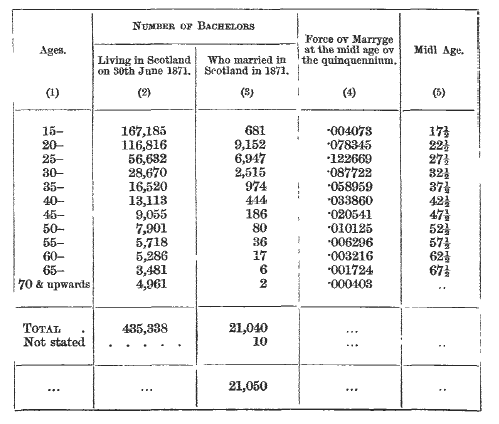No CrossRef data available.
Article contents
On the Construction of a Combined Marriage and Mortality Table from Observations made as to the Rates of Marriage and Mortality among any body of Men; and on the Calculation of the Values of Annuities and Assurances that depend on the Contingency of Marriage as well as Death, and their application to determine the Rate of Premium for an Insurance against the Contingency of a Bachelor of a given age leaving Issue: illustrated by various Tables calculated from the experience of the British Peerage families
Published online by Cambridge University Press: 18 August 2016
Extract
In valuing interests that involv the probabilitys ov marryge and ov leaving issue, we require to hav the means ov ansering such questions as the folloing among others. What is the probability that a bachelor ov a givn age wil (1) marry, or (2) die unmarryd, in an asignd year from the present time? or (3) be alive and stil unmarryd after the laps ov a givn number ov years ? In ordinary life contingency calculations, the corresponding questions as to the probabilitys ov life and deth ar anserd by means ov the figurs containd in the familiar mortality tabl (formerly cald a tabl ov mortality, but by Dr. Farr a life tabl); and the great practical convenience ov that tabl sugests that, when we hav to deal with chances ov marryge as wel as ov deth, we shoud at the outset construct on analogos principls a combined marryge and mortality tabl.
- Type
- Research Article
- Information
- Copyright
- Copyright © Institute and Faculty of Actuaries
References
page 407 note * Mr. S. Brown states (J.I.A. xi, 11) that G. Davies “obtained the rate of mortality for the average age in each rank, and then, as he says, 'laid down a curve, taking the age as the abscissa and the mortality per-cent as the corresponding ordinate, making the inflections thereof as regular as I could, so as to preserve the character of a continued curve, 'This, it must be admitted, was a very rough way of deducing a table from original observations,” I do not agree with Mr. Brown if he intends to imply that this graphic process is necessarily a very rough way of deducing a graduated table from the original facts.
page 422 note * The following tabl, calculated by Mr.Morgan, A. H., ov the Scottish Equitable life Assurance Society Google Scholar, relates to marryges ov bachelors in Scotland, and may be compared with Mr. Day's figurs (J.I.A. viii, 130 and 133). The Scotch Census Report ov 1871 givs (vol. ii, p. 137) the number ov bachelors alive at each quinquennium ov age on 3rd April 1871; but, for the purpos ov strict comparison with the marryges in the year 1871, we require the number alive in the midl ov the year. The Registrar-General for England (40th Annual Report, p. 107) estimates that the total male population ov Scotland increast from 1,603,143 on 3rd April to 1,607,276 on 30th June, being in the ratio ov 1 to 1·002578; and it was asumed that the number ov bachelors at each quin-quennium ov age increast in the same proportion. Mr. Day dos not seem to hav tho't it worth while to make this corection for increas ov population. The marryges ov bachelors, as stated in col. 3, ar givn in the 17th Detaild Annual Report ov the Scotch Registrar-General, p. 25.
In one respect the Sccotchstatistics apear greatly preferabl to the English, for in 10 cases only out of 21,050 wer the ages ov bachelors who marryd not stated, whereas in the English statistics used by Mr. Day, the number ov bachelors whos ages wer not stated was 84,088 out ov 132,643. Comparing the two tables it wil be seen that under the age ov 25 the marryge rate is considerably loer in Scotland than in England, from 25 to 30 it is practically the same, and abov 30 it is uniformly hiher than in England. If therefore thefigurear to be trusted, marryges, as a rule, take place at later ages in Scotland than 5n England. It is to be notist, however, that Mr. Day asumes that the 84,088, whos ages ar not stated, may be distributed over the varies ages in the same proportion as the 48,555 whos ages ar stated. If this is not the case, but the former ar on the average older than the latter, this may perhaps be suficient by itself to explain the difference between his figure and these.



